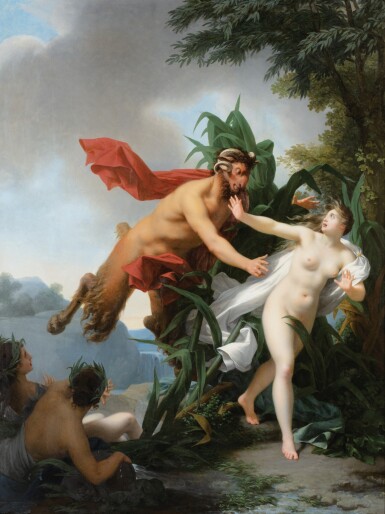
L'œil et l'histoire: paintings from a french private collection (lots 23, 24, 65, 66 and 139, 140, 149, 152, 153, 154, 197)
Jean-Baptiste Regnault
Pan and Syrinx
Auction Closed
June 15, 02:40 PM GMT
Estimate
50,000 - 70,000 EUR
Lot Details
Description
L'œil et l'histoire: paintings from a french private collection (lots 23, 24, 65, 66 and 139, 140, 149, 152, 153, 154, 197)
Jean-Baptiste Regnault
Paris 1754 - 1829
Pan and Syrinx
Signed and dated lower right Regnault p 1828. agé de 73.
Oil on canvas
130 x 96,9 cm ; 51¼ by 38⅛ in.
__________________________________________________________________________
L'œil et l'histoire : tableaux d'une collection privée française (lots 23, 24, 65, 66 et 139, 140, 149, 152, 153, 154, 197
Jean-Baptiste Regnault
Paris 1754 - 1829
Pan et Syrinx
Signé et daté en bas à droite Regnault p 1828. agé de 73.
Huile sur toile
130 x 96,9 cm ; 51¼ by 38⅛ in.
Baron Regnault;
By descent to Miss Nocard;
Her sale, Paris, Ader-Picard-Tajan, 17 June 1980, lot 59.
__________________________________________________________________________
Baron Regnault ;
Par descendance à Mademoiselle Nocard ;
Sa vente, Paris, Ader-Picard-Tajan, 17 juin 1980, lot 59.
A well-known Neoclassical painter and a rival of Jacques Louis David, Jean-Baptiste Regnault exhibited regularly at the Salon between 1783 and 1802. He was deeply interested in classical and mythological subjects, a genre in which he excelled, and won the Prix de Rome in 1776 with his Alexander Visiting Diogenes.
In 1783, Regnault was admitted to the Académie Royale de Peinture et de Sculpture. Teaching had an important place in the painter's life and he trained many artists in his studio at the Louvre. He was also one of the first to open his studio to female artists, at a time when the Académie struggled to acknowledge more than a handful of women – and the recently founded Institut National des Sciences et des Arts remained exclusively male.
In his mature works, Regnault turned to more ambitious projects and larger formats. Created a year before his death, Pan and Syrinx is one of the artist's last paintings. After signing and dating the canvas, he added, with a touch of pride, that he was seventy-three years old.
The scene is inspired by a passage from Ovid's Metamorphoses. Pan pursues the nymph Syrinx, who escapes her attacker by turning into water reeds. There is a preparatory drawing for this composition in pierre noire, pen and wash. Both the painting and the drawing were for a long time in the collection of Baron Regnault's descendants, before being sold in 1980.
__________________________________________________________________________
Peintre néoclassique reconnu et rival de Jacques Louis David (1748-1825), Jean-Baptiste Regnault expose régulièrement au Salon entre 1783 et 1802. Prix de Rome en 1776, avec son Diogène visité par Alexandre, il se passionne pour les sujets antiques et mythologiques, genre dans lequel il excelle.
En 1783, Regnault est reçu à l'Académie royale de peinture et de sculpture. L'enseignement occupe une place importante dans la vie du peintre, qui forme de nombreux artistes dans son atelier du Louvre. Il est en outre l'un des premiers à ouvrir son atelier aux peintres femmes, à une époque où l'Académie accepte difficilement une poignée d'entre elles et où l'Institut, tout juste fondé, demeure exclusivement masculin.
Pour ses œuvres de maturité, Regnault s’adonne à des projets plus ambitieux et à des plus grands formats. Exécuté un an avant sa mort, Pan et Syrinx est l’un des derniers tableaux de l’artiste, qui après avoir signé et daté la toile, précise non sans une certaine fierté, être âgé de 73 ans.
La scène s’inspire d’un passage des Métamorphoses d’Ovide. Pan poursuit la nymphe Syrinx, qui se transformera en roseaux pour échapper à son assaillant. Il existe un dessin préparatoire à cette composition, réalisé à la pierre noire, plume et lavis. Le tableau et le dessin restèrent longtemps dans la collection des descendants du Baron Regnault, avant d’être finalement séparés lors de la vente en 1980.
You May Also Like










